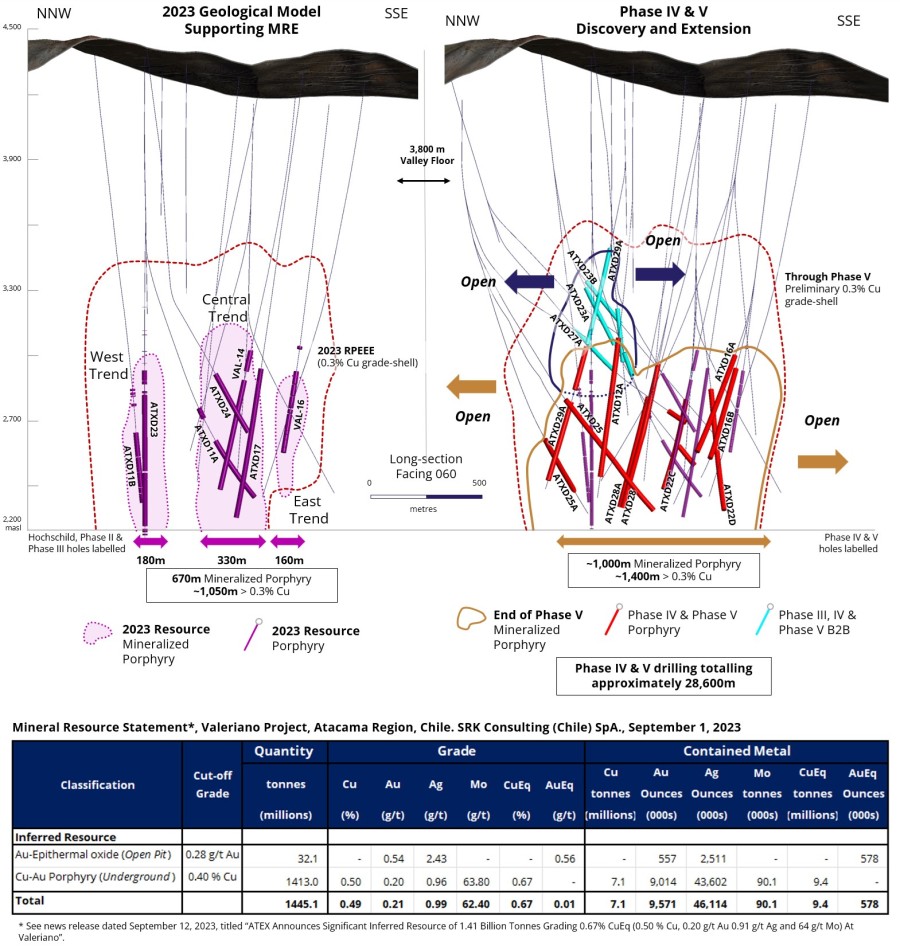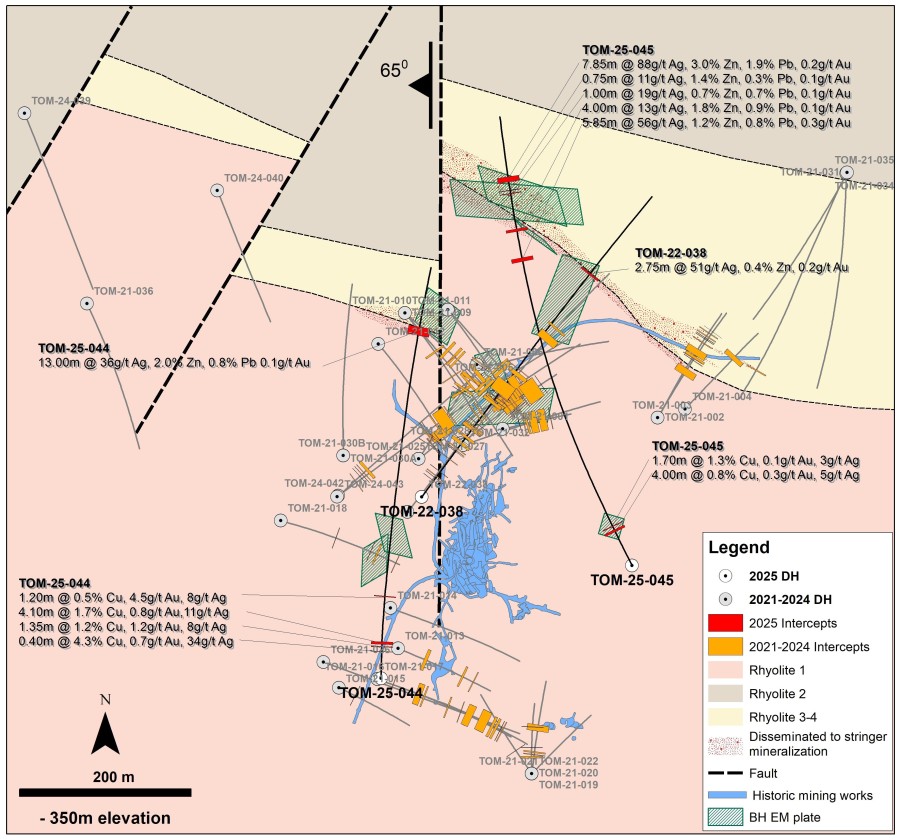TORONTO, Dec. 11, 2017 (GLOBE NEWSWIRE) -- LSC Lithium Corporation (“LSC” or together with its subsidiaries, the “Company”) (TSXV:LSC) is pleased to announce the completion of the second drill hole, SPG-2017-04A, in its 6 hole Phase 1 program on Salar de Pastos Grandes. The receipt of lithium brine assay results for this hole indicate extensive and open ended mineralization to depth.
HIGHLIGHTS
- Peak value intersected of 528 mg/l Li
- Three thick zones of lithium mineralization recorded down hole and remains open at depth
- Three wide zones of lithium mineralization intersected including:
- 62m at 500 mg/l Li from 342m with an average Mg/Li ratio of 6.7
- 110m at 388 mg/l Li from 192m with an average Mg/Li ratio of 6.6
- 83m at 326 mg/l Li from 9m with an average Mg/Li ratio of 6.3
- Mineralization footprint considerably extended on the Salar
- LSC’s tenements total 2,683 ha over Salar de Pastos Grandes, with 75% of LSC’s tenements (2,012 ha) present on the Salar surface itself
- On track to deliver a NI 43-101 Mineral Resource report in Q2, 2018
- LSC is considering combining production from Pastos Grandes and its Pozuelos project, only 17 km away, with centralized processing at Pozuelos due to brine chemistry similarities and capital and operating cost savings. LSC anticipates delivering a NI 43-101 Mineral Resource statement on its Pozuelos project by year end
The Company is pleased to report the completion of its second drill hole SPG-2017-04A on the Pastos Grandes property (see Map 1). This hole has returned consistently high lithium grades and is open ended at depth (see Table 1). This set of results extends the mineralized footprint on LSC’s tenements, demonstrates the quality of this Salar and is in line with LSC’s plan to deliver a NI 43-101 Mineral Resource report in Q2, 2018. The previous results announced for the first drill hole, SPG-2017-02B,1 also indicated a thick sequence of lithium bearing brine mineralization which was open ended at depth below 500m. See Table 2 for a summary of LSC’s drill program on the Salar de Pastos Grandes.

Well mineralized lithium bearing brine aquifers intersected in the current drill hole are present in three main zones, the upper zone, from 9m to 92m, is dominated by halites, the middle zone, from 192m to 302m, is represented by interbedded halites and fine grained sands and the bottom zone, from 342 to 404m, consists of interbedded fine grained sands, clays and halite, but is also open ended at depth. The upper zone averages 326 mg/l Li over 83m with a Mg/Li ratio ranging between 6.08 and 7.10, the middle zone averages 388 mg/l Li over 110m with a Mg/Li ratio ranging between 6.27 and 6.98 and the bottom zone averages 500 mg/l Li over 62m with a Mg/Li ratio ranging between 6.59 and 6.79 and is open ended at depth. Brine packers were taken to a depth of 404m but due to unstable in-hole conditions experienced from 404m to the end of the hole at 554m, this zone was not sampled. Despite this, the geology was logged as being the same material as for the high-grade zone above.
LSC’s President & CEO Ian Stalker, noted “The consistency of both the areal extent and thick zones of the lithium mineralization that continues to be intersected on Pastos Grandes is extremely encouraging. LSC is well on its way to delivering a mineral resource report on this project in the first half of next year. In addition, we are making good progress in moving our other key projects which include Rio Grande, Pozuelos, Salinas Grandes and Jama, through various stages of development culminating in the delivery of three Mineral Resource estimates over the next four months”.
Table 1: Brine Packer Sample Results
Salar de Pastos Grandes Drill Hole SPG-2017-04A
(Results as of December 6, 2017)
| Hole | From | To | Li | Mg/Li | SO4/Ca | Mg/Ca | K/Li | SO4/Li | Density |
| (m) | (m) | mg/L | Ratio | Ratio | Ratio | Ratio | Ratio | G/ml | |
| SPG-2017-04A | 9 | 11 | 312 | 6.10 | 9.34 | 2.37 | 9.93 | 24.08 | 1.22 |
| 36 | 38 | 313 | 6.08 | 9.11 | 2.37 | 9.88 | 23.38 | 1.22 | |
| 42 | 44 | 315 | 6.10 | 9.41 | 2.38 | 9.88 | 24.12 | 1.22 | |
| 48 | 50 | 313 | 6.16 | 9.47 | 2.39 | 9.96 | 24.40 | 1.22 | |
| 66 | 68 | 319 | 6.23 | 9.79 | 2.46 | 10.23 | 24.77 | 1.22 | |
| 72 | 74 | 359 | 6.29 | 10.47 | 2.94 | 10.47 | 22.36 | 1.22 | |
| 90 | 92 | 350 | 7.10 | 10.41 | 3.37 | 10.23 | 21.92 | 1.22 | |
| 192 | 194 | 308 | 6.27 | 8.84 | 2.46 | 10.14 | 22.52 | 1.22 | |
| 214 | 216 | 445 | 6.89 | 15.10 | 4.70 | 10.87 | 22.14 | 1.22 | |
| 220 | 222 | 519 | 6.66 | 18.70 | 6.00 | 10.93 | 20.74 | 1.22 | |
| 252 | 254 | 307 | 6.40 | 8.87 | 2.50 | 10.23 | 22.68 | 1.22 | |
| 256 | 258 | 519 | 6.63 | 18.32 | 5.98 | 11.00 | 20.32 | 1.22 | |
| 258 | 260 | 311 | 6.33 | 8.92 | 2.52 | 10.24 | 22.43 | 1.22 | |
| 264 | 266 | 376 | 6.65 | 10.68 | 3.46 | 10.59 | 20.53 | 1.22 | |
| 268 | 270 | 329 | 6.95 | 9.41 | 2.93 | 10.32 | 22.33 | 1.22 | |
| 270 | 272 | 315 | 6.35 | 9.03 | 2.56 | 10.34 | 22.42 | 1.22 | |
| 274 | 276 | 327 | 6.98 | 9.47 | 2.93 | 10.27 | 22.56 | 1.22 | |
| 276 | 278 | 375 | 6.58 | 10.58 | 3.38 | 10.50 | 20.59 | 1.22 | |
| 286 | 288 | 525 | 6.62 | 17.13 | 5.80 | 11.03 | 19.54 | 1.22 | |
| 288 | 290 | 328 | 6.52 | 9.48 | 2.80 | 10.49 | 22.10 | 1.22 | |
| 292 | 294 | 362 | 6.36 | 10.96 | 3.25 | 10.58 | 21.42 | 1.22 | |
| 294 | 296 | 352 | 6.57 | 10.13 | 3.12 | 10.63 | 21.36 | 1.22 | |
| 300 | 302 | 517 | 6.75 | 17.44 | 5.73 | 11.06 | 20.54 | 1.23 | |
| 342 | 344 | 534 | 6.79 | TBA | 6.30 | 10.99 | TBA | TBA | |
| 372 | 374 | 539 | 6.77 | TBA | 6.36 | 11.22 | TBA | TBA | |
| 396 | 398 | 400 | 6.59 | TBA | 3.71 | 10.61 | TBA | TBA | |
| 402 | 404 | 528 | 6.76 | TBA | 6.14 | 11.24 | TBA | TBA |
TBA=Results Pending
Table 2: Drill Program Summary – Salar de Pastos Grandes
| Hole | POSGAR 94 datum | Depth (m) | Azimuth | Dip | Type | Size | |
| Northing | Easting | ||||||
| SPG-2017-02 | 7 285 188 | 3 426 958 | 121 | 0 | 90 | DDH | HQ |
| SPG-2017-02b | 7 284 054 | 3 427 202 | 573 | 0 | 90 | DDH | HQ |
| SPG-2017-04A | 7 283 169 | 3 430 376 | 554 | 0 | 90 | Tricone | 3 7/8” |
Brine samples are recovered from the diamond holes using a packer system to isolate specific levels in the holes and assayed at Alex Stewart Assayers (“ASA”) in Jujuy, Argentina.
Capitalization Update
LSC also announces that as of November 30, 2017 the capitalization of LSC is as described below:
| Share Capital | |
| Shares Outstanding | 141.6 million |
| Options(1) | 9.4 million |
| Warrants | 10.8 million |
| Fully Diluted Shares Outstanding | 161.8 million |
(1) Options have an exercise price of C$1.30 and vest over three years. All options expire 5 years after the date of issuance.
LSC also announces that the Board of Directors of LSC granted 600,000 options to purchase common stock to employees and consultants at an exercise price of C$1.60 per common share, for a term of five years, pursuant to LSC’s incentive stock option plan. The new stock option grants that have been made to new employees and officers are part of the Company's overall annual compensation package. As a result of this grant, LSC has 9,975,000 stock options issued, representing 7.04% of the issued and outstanding share capital.
Sampling and QA/QC
Brine sampling for packer tests involved collection of brine from the sample interval in a 20-litre container, which was flushed with fresh brine several times prior to collection of the sample. Brine was poured into 1-litre sample bottles which had been previously flushed with fresh brine from the 20-litre container several times. Sample bottles were filled to the top to eliminate the inclusion of air and sealed with a leak proof lid. Samples were labelled and labels covered in clear tape to prevent erasure of sample information. All samples remained in the possession of the site geologist until delivery to Alex Stewart Laboratory in Mendoza, Argentina by courier.
LSC has a well-developed QA/QC program. Brine assays are undertaken at ASA in Mendoza, Argentina. ASA is independent of LSC and has significant experience in assaying lithium brines and is certified to ISO17025 standards. Brine assays are undertaken using ICP, gravimetric, potentiometric and volumetric methods as detailed in a press release from LSC dated April 10, 2017.
ASA runs internal duplicates at a rate of 1 in 20. LSC inserts blanks and standards in sample batches at a rate of 1 in 20. Standards are internal standards developed by LSC that have been independently certified by round robin testing. LSC uses distilled water as blanks.
Qualified Person/Data Verification
The scientific and technical information included in this press release is based upon information prepared and approved by Donald H. Hains, P.Geo. Mr. Hains is a qualified person, as defined in NI 43-101 and is independent of LSC. Mr. Hains has verified all sampling, analytical and test data underlying the information contained in this press release by on-site inspection during drilling, brine sampling; review of drill core photographs to verify lithology; review of certified assay certificates against the assay data base; review of pump test data. There are no drilling, sampling, recovery or other factors that could materially affect the accuracy and reliability of the data.
ABOUT LSC LITHIUM CORPORATION:
LSC Lithium has amassed a large portfolio of prospective lithium rich salars and is focused on developing its tenements located in five salars: Pozuelos, Pastos Grandes, Rio Grande, Salinas Grandes, and Jama. All LSC tenements are located in the “Lithium Triangle,” an area at the intersection of Argentina, Bolivia, and Chile where the world’s most abundant lithium brine deposits are found. LSC Lithium has a land package portfolio totaling approximately 300,000 hectares, which represents extensive lithium prospective salar holdings in Argentina.





